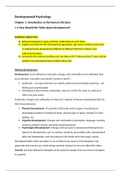Samenvatting
Summary Chapter 1 Introduction to the Human Life Span
- Instelling
- Rijksuniversiteit Groningen (RuG)
Detailed summary of Chapter 1: Introduction to the Human Life Span, in Carol K. Sigelman & Elizabeth A. Rider's 'Life-Span Human Development, 9th Edition.
[Meer zien]






